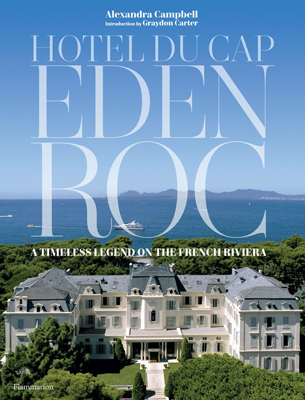Celebrating the sesquicentennial of one of the most luxurious getaways on Earth…
For a century and a half, the Hotel du Cap, on the southernmost tip of Cap d’Antibes on France’s Côte d’Azur, has been the preferred playground for iconic figures of every decade — “from the Belle Époque, through the Jazz Age, the jet age, the 1960s and ’70s, right up to the present.” So begins a lavish new coffee table book, Hotel du Cap-Eden-Roc: A Timeless Legend on the French Riviera, by Alexandra Campbell (published by Flammarion), on the world’s most famous luxury hotel, which just celebrated its 150th anniversary.
In 1870, Hippolyte de Villemessant, the founder of France’s Le Figaro newspaper, built a chateau in the style of Napoleon III called Villa Soleil for writers “seeking inspiration.” Later renamed the Grand Hotel du Cap, in 1987 it became the Hotel du Cap-Eden- Roc — incorporating the name of its celebrated seaside pavillion and saltwater swimming pool, carved out of basalt rock — and since 1964 has been part of what is now the Oetker Collection of iconic hotels, which includes Le Bristol Paris and the Château Saint- Martin & Spa in Provence.
“In the 1920s and 1930s, this magnificent palace hotel on the Cap d’Antibes first became one of the world’s most desirable and soughtafter holiday destinations,” Campbell writes, “drawing artists and writers like Matisse, Léger and Picasso, Anatole France, F. Scott Fitzgerald, Ernest Hemingway, Dorothy Parker, George Bernard Shaw, Somerset Maugham and Noël Coward.” In addition to the creative types, it soon attracted the likes of Winston Churchill as well as “royalty from around Europe and further afield, [who] found there an incomparable beauty together with fun and relaxation away from prying eyes.”
Gerald and Sara Murphy, an American couple well known for their great wealth, beauty, taste and style, who moved to France in the 1920s and inspired the characters Dick and Nicole Diver in Fitzgerald’s Tender Is the Night, once rented the hotel for an entire season, well before the French Riviera became a fashionable summer escape. The Murphys brought Hemingway and Fitzgerald, who in turn attracted other legends of the Lost Generation, which inspired yet more moneyed travellers to seek it out. As the Hollywood Reporter once recounted, “From Marlene Dietrich to Madonna, the hotel has [always] been a home away from home for the super-famous.”
The Kennedy family summered there in 1938, “when JFK was 21 years old. Picasso drew the restaurant’s menu in 1955,” around the time Hemingway was in residence. “Darryl Zanuck and Orson Welles treated the hotel like a second home, [while] The Duke and Duchess of Windsor honeymooned there, as did Elizabeth Taylor and Richard Burton.” Rita Hayworth chose it for her rendezvous with Prince Aly Khan, and of course the great Slim Aarons immortalised it on film.
The hotel’s fascination for Hollywood stems from the founding of the Cannes Film Festival nearby in 1946; in the mid-1990s, former Vanity Fair editor Graydon Carter threw the first of many lavish parties at the hotel during the festival, imbuing the storied edifice with even more luster. In his introduction to the Flammarion book, Carter notes that before he arrived on the scene, “the postwar years brought their own brand of glamour: the guest list included Peter Sellers, John Lennon and Yoko Ono, Romy Schneider, Serge Gainsbourg and Jane Birkin, Michael Caine, Robert Evans, Rock Hudson and Doris Day.”
In their wake came Sean Connery, who was “a regular guest. As was Pierce Brosnan. Roger Moore used to live nearby in the 16thcentury town of Valbonne and, when he wasn’t working, would come every day to play tennis,” giving the hotel the 007 stamp of approval. Later still Clint Eastwood, Harrison Ford and Robert De Niro all turned up. “To the staff, they were movie stars second and gentlemen first,” Carter notes. “There are grander hotels than the Hotel du Cap,” as Carter declares. “There are more expensive hotels than the Hotel du Cap. But there is no hotel with such subtleties of setting, purpose, and service like the Hotel du Cap. It stands by itself on the cliffs of Cap d’Antibes, a world apart. It may be turning 150, but I will say that on a glorious early summer evening, it doesn’t look a day over 30…. as fresh as when Slim Aarons took that iconic photograph of the pool in 1976.” ■

By JARED PAUL STERN
For the full article grab the September 2021 issue of MAXIM Australia from newsagents and convenience locations. Subscribe here.




